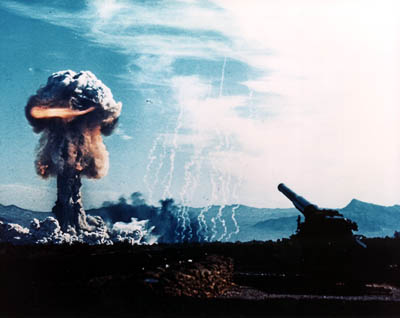Nuclear artillery
Shortly after the development of the first atomic bombs the USA and the USSR began investigations into devices with limited yield that could by used in sub-strategic situations, even tactically. This developed into a number of short-range delivery systems and low yield warheads from the late 1950s onwards. The weapons included landmines, depth charges, torpedoes, demolition munitions and artillery shells.
US nuclear artillery

Operation Upshot/Knothole, a 1953 test of a
nuclear artillery projectile at Nevada Test Site
(photo depicts 280 mm gun and explosion)
The US development resulted in a number of test weapons. The first artillery test was on May 25, 1953 at the Nevada Test Site. Fired as part of Operation Upshot-Knothole and codenamed Shot GRABLE a 280 mm shell with a gun-type fission warhead was fired 10,000 m and detonated 160 m above the ground with an estimated yield of 15 kilotons. This was the only nuclear artillery shell actually fired. The shell was 1384 mm long and weighed 365 kg, it was fired from a specially built artillery piece by the Artillery Test Unit of Fort Sill, Oklahoma. Around 3,200 personnel were present. The warhead was designated the W-9 and 80 were produced from 1952-53 for the T-124 shell, it was retired in 1957.
Development work continued and resulted in the W-19. A 280 mm shell it was a linear development of the W-9. Only 80 warheads were produced and the system was retired in 1963 with the development of the W-48 warhead. The W-48 was 846 mm long and weighing 58 kg, it could be fitted in a 155 mm M-45 AFAP (artillery fired atomic projectile) and used in a more standard 155 mm howitzer. The fission warhead was a linear implosion type, consisting of a long cylinder of subcritical mass which is compressed and shaped by explosive into a supercritical sphere. The W-48 yielded just 72 tons TNT equivalent.
The W-48 went into production from 1963, 135 examples of the Mod 0 variant were built up to 1968 when it was retired. It was replaced by the Mod 1 which was manufactured from 1965 up until 1969, 925 of this type were made. Efforts were made to update the warheads, the 203 mm W-74 was developed from around 1970, intended to have a yield of 100 tons or higher it was cancelled in 1973. A further development program began in the 1980s, the W-82 was for a 155 mm shell, the XM-785, it was intended to yield up to 2 kt with an enhanced radiation capability. Development was halted in 1983, a W-82-1 fission only type was designed but finally cancelled in 1990.
Other developments also continued. In 1958 a fusion warhead was developed and tested, the UCRL Swift. It was 622 mm long, 127 mm diameter, and weighed 43.5 kg. At its test it yielded only 190 tons, it failed to achieve fusion and only the initial fission explosion had worked correctly. As well as linear implosion devices the US developed a spherical implosion device that was very close to the theoretical limit of nuclear weapons. The Mk-54 Davy Crockett was designed to be fired from the M-388 recoilless rifle. Weighing only 23 kg the warhead, in its casing, was 400 mm by 273 mm. It was first tested in October 1958 as part of Operation Hardtack and yielded 10 tons, later developments increased that to 1 kt. 400 Mk-54 warheads were produced from 1961-65 and the last was withdraw in 1971. The warhead was also adapted for the Mk-54 SADM (Special Atomic Demolition Munition), this was a cylinder 40 cm by 60 cm and weighed 68 kg, fired by a mechanical timer it had a variable yield from 10 tons up to 1 kt. 300 SADMs were made and they remained in the US arsenal until 1989.
Only one type of artillery round other than the W-48 was produced in large numbers, the W-33 for use in a 203 mm shell. Around 2,000 warheads of this type were manufactured from 1957-65, each was 940 mm long and weighed around 109 kg, they were fitted in the T-317 AFAP and fired from a specialised howitzer. The warhead yield was greater than the W-48 and it was made in four types, three yielding 5 to 10 kt and one 40 kt.
In 1991 the US unilaterally withdrew its nuclear artillery shells from service, and Russia responded in kind in 1992. The US removed around 1,300 nuclear shells from Europe.
